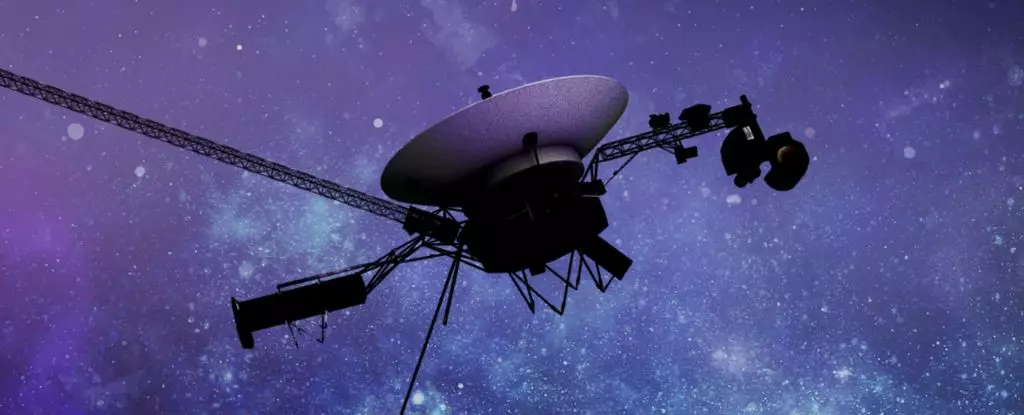In October 2023, NASA faced a compelling challenge as it temporarily lost contact with the iconic Voyager 1, the farthest human-made object from Earth. This event underscores the inherent complexities of operating technology that has endured nearly half a century in the harsh environment of space. What was startling about this episode was that when communication was reestablished, Voyager 1 was utilizing a transmitter that hadn’t been in use for over 40 years. Such unexpected developments showcase both the resilience of the Voyager spacecraft and the challenges that come with remote space exploration.
The issue began on October 16, when a seemingly straightforward command was sent to Voyager 1, instructing it to activate one of its heaters. This request, however, resulted in an unanticipated communication blackout that took NASA two days to identify. The distance—nearly 25 billion kilometers (15.3 billion miles)—creates a significant delay, with messages taking almost 23 hours to transmit in each direction. It is a sobering reminder of the logistical constraints inherent to interstellar missions.
On October 18, the first sign of trouble emerged as Voyager 1 failed to respond to its scheduled communications check. The Deep Space Network (DSN) quickly commenced efforts to locate a signal, ultimately detecting it on an unexpected frequency band. The issue was diagnosed as a result of Voyager 1’s built-in fault protection system, triggered by the heater command. This system is designed to conserve power by disabling non-essential functions whenever an instrument draws excessive energy, putting the craft’s operational stability into question.
Following the initial communication restoration, stability was short-lived. The next day, signals from Voyager 1 were entirely absent. Analysis revealed that the X-band transmitter, which serves as the main communication pathway to Earth, had likely activated the fault protection system multiple times. As a result, Voyager 1 switched to its S-band transmitter, a device that although conserves power, transmits signals that are weaker and less detectable than those from the X-band system. The last time Voyager 1 used the S-band transmitter was back in 1981, when it operated in a considerably closer orbit.
Faced with the prospect of only being able to communicate using this antiquated system, NASA engineers experienced a period of uncertainty. The gap in communication raised concerns about the feasibility of re-establishing contact at such vast distances, particularly since Voyager 1 was untested in this mode for decades.
The Engineers’ Persistence
Fortunately, on October 22, DSN engineers successfully confirmed that the S-band transmitter was functional through a series of commands. However, the decision was made to refrain from reactivating the X-band transmitter until a conclusive understanding of the failure could be achieved. This cautious approach illustrates NASA’s methodical and thorough troubleshooting processes, which emphasize the need for careful management of these aging spacecraft.
The underlying theme in this incident is the longevity of Voyager 1’s technology, which beyond being an engineering marvel, also highlights the increasing operational challenges the Voyager probes face as they continue to traverse the unpredictable environment of interstellar space. Last year’s transmission mishaps, including the erroneous telemetry that persisted for months and errors tied to memory chip corruption, accentuate the inevitable deterioration of technology over time.
The Voyagers’ Legacy and Future
As the Voyager missions push forward into a region of space unlike any other explored by humanity, their scientific contributions become ever more invaluable. Both spacecraft have provided unique insights into our solar system and beyond, yet they are slowly approaching the end of their operational capabilities. With power supplies diminishing, it is anticipated that Voyager 1 will cease collecting scientific data after 2025, leading towards a complete loss of contact by 2036 when they fall out of range of the Deep Space Network.
Yet even after the loss of communication, Voyager probes will not simply cease to exist. They will carry on their silent journey through the darkness, eventually passing near other stars thousands of years in the future. This perspective on their trajectory reflects humanity’s relentless pursuit of exploration and knowledge, encapsulated in these mechanical emissaries that might bear the last remnants of human culture far beyond the threshold of our solar system.
While these challenges pose risks to ongoing research and data collection, they also embody the spirit of human inquiry and resilience in the face of adversity as we venture into the cosmos. Voyager 1’s journey will eventually become a monument to human curiosity, showcasing our quest to understand the universe and our place within it.


Leave a Reply